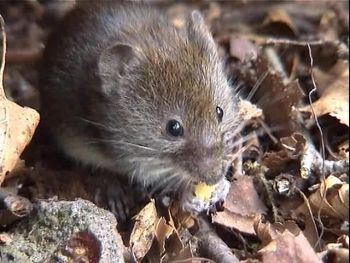
Publisher:
Bonnie King
CONTACT:
Newsroom@Salem-news.com
Advertising:
Adsales@Salem-news.com

~Truth~
~Justice~
~Peace~
TJP
Jan-15-2009 19:09

 TweetFollow @OregonNews
TweetFollow @OregonNews
Group Links Global Warming to European Viral Epidemic
Salem-News.comThe authors believe that warmer weather causes increases in the amount of âmastâ, plant seeds from oak and beech trees, that forms the volesâ staple diet.
 The animal-borne disease, scarcely known before 1990, has been increasing in incidence in Belgium with a cyclic pattern, reaching epidemic proportions since 2005. Courtesy: voles.com |
(BRUSSELS) - An epidemic of the viral disease nephropathia epidemica (NE) has been linked to increases in the vole population caused by hotter summers, milder winters and increased seedcrop production by broadleaf trees.
Research published in BioMed Centralâs open access International Journal of Health Geographics links outbreaks of this rodent-borne disease to known effects of global warming.
Dr Jan Clement from the Department of Microbiology & Immunology at Belgiumâs Rega Institute (University of Leuven) worked with a team of medical researchers and bioscience-engineers to investigate outbreaks of NE in Belgium.
Dr. Clement founded the Belgian Hantavirus Reference Centre in 1985, and noted that of the 2,200 cases since then, 828 (37.6%) occurred in just the last three years, 2005-2007. The epidemic has been shown to extend to neighboring countries such as France, Germany, The Netherlands, and Luxembourg.
He said, âThis animal-borne disease, scarcely known before 1990, has been increasing in incidence in Belgium with a cyclic pattern, reaching epidemic proportions since 2005. The fact that the growing combined effect of hotter summer and autumn seasons is matched by the growth of NE in recent years means this epidemic can be considered an effect of global warmingâ.
NE is caused by infection with Puumala virus (PUUV), which is spread by the bank vole, a rodent common throughout most of Europe.
The authors believe that warmer weather causes increases in the amount of âmastâ, plant seeds from oak and beech trees, that forms the volesâ staple diet. This plethora of food results in increases in the vole population and warm summers raise the chances that people will visit the forests where the voles live.
According to Clement, âSince 1993, each NE peak has been preceded by increased autumnal mast formation the year before, resulting in yearly NE numbers significantly higher than those during the mast years themselvesâ.
PUUV is a hantavirus, a group of viruses known to cause hemorrhagic fevers (fevers combined with bleeding disorders). NE is a relatively mild hemorrhagic fever that causes flu-like symptoms often with renal complications, sometimes also with pulmonary problems, needing Intensive Care treatment, such as acute dialysis and/or mechanical ventilation. In some rare cases it can, moreover, cause the shock with internal haemorrhaging and death for which these infections are infamous.
Clement said, âIn 1997, more than 9,000 people in the Russian republic of Bashkortostan contracted the disease, of which 34 cases were fatalâ.
Articles for January 14, 2009 | Articles for January 15, 2009 | Articles for January 16, 2009


googlec507860f6901db00.html

Quick Links
DINING
Willamette UniversityGoudy Commons Cafe
Dine on the Queen
Willamette Queen Sternwheeler
MUST SEE SALEM
Oregon Capitol ToursCapitol History Gateway
Willamette River Ride
Willamette Queen Sternwheeler
Historic Home Tours:
Deepwood Museum
The Bush House
Gaiety Hollow Garden
AUCTIONS - APPRAISALS
Auction Masters & AppraisalsCONSTRUCTION SERVICES
Roofing and ContractingSheridan, Ore.
ONLINE SHOPPING
Special Occasion DressesAdvertise with Salem-News
Contact:AdSales@Salem-News.com

Terms of Service | Privacy Policy
All comments and messages are approved by people and self promotional links or unacceptable comments are denied.
JJ January 16, 2009 12:01 pm (Pacific time)
What warm weather? It's been the coldest winter, ice, snow, freezing temperature. When do they realize that Global Whining doesn't exist?
[Return to Top]©2026 Salem-News.com. All opinions expressed in this article are those of the author and do not necessarily reflect those of Salem-News.com.